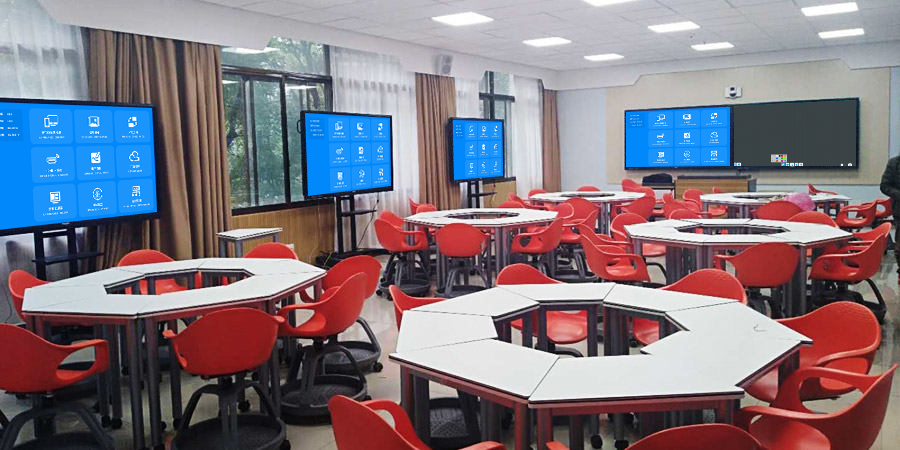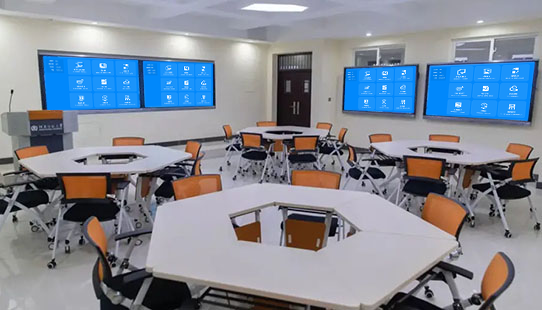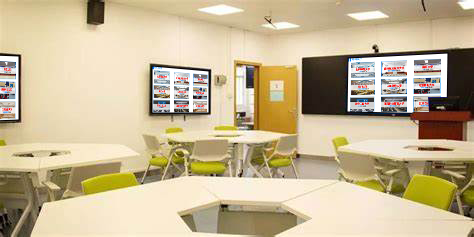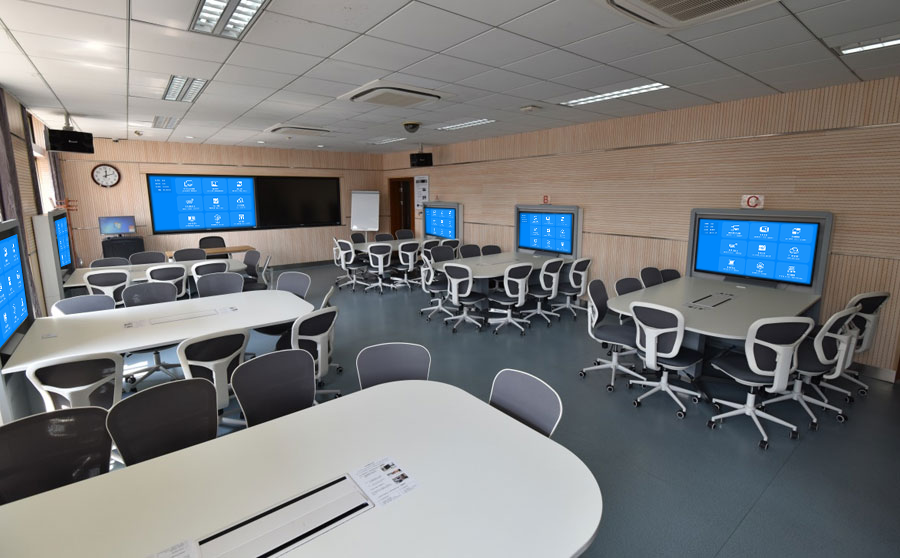Smart Classrooms: Reshaping Teaching Scenarios, Making Interaction Accessible
In the wave of digital transformation in education, smart classrooms are breaking the traditional spatial and temporal constraints of teaching. By leveraging technology, they construct a comprehensive teaching closed-loop encompassing “pre-class preparation – in-class interaction – post-class consolidation.” Built on multi-device collaboration and centered on interactive functions, smart classrooms make knowledge transfer more vivid and teacher-student collaboration more profound, redefining the value of the classroom.
I. All-Device Wireless Interconnection: Building a Barrier-Free Education Ecosystem
(I) Seamless Cross-Terminal Integration
Smart classrooms support multi-device interconnection including phones (iOS/Android), computers (Windows/macOS), tablets, electronic whiteboards, and group screens. Through full-protocol screen mirroring technologies like AirPlay, Miracast, and WiDi, educational resources flow freely. A teacher can mirror courseware from a MacBook, students can submit assignments from Android tablets, and a lab can display experimental data from a Windows computer, all without worrying about device compatibility issues, ensuring unimpeded information flow in the classroom. For example, in a physics class, the teacher mirrors a mechanics animation, students use tablets to mark stress points, and the content synchronizes to group screens for discussion, making abstract knowledge concrete.
(II) One-Click Interconnection + Rapid Switching
Teachers can project courseware to the main screen within 3 seconds by scanning a QR code with their phone or entering a 6-digit pin code. The system supports 8 devices connecting simultaneously, boosting switching efficiency by 90% when 6 groups in a classroom take turns presenting their results, eliminating the need for repeated disconnections. Students can also proactively mirror their problem-solving ideas using a “screen grab” function, shifting classroom participation from passive reception to active expression. For instance, a group recitation video in a language arts class can be one-click mirrored to the main screen for the whole class to appreciate.
II. Upgraded Interactive Features: Transforming Classrooms from “Listening” to “Co-creation”
(I) Real-Time Annotation and Feedback
Both the main screen and group screens have built-in electronic whiteboard functions. While explaining, teachers can circle key points on courseware, write out derivations, and their annotations synchronize to all student devices in real-time. Students can also annotate questions on the mirrored content on their own terminals, which the teacher can view in real-time on the main screen and address specifically, avoiding knowledge gaps caused by “classroom silence.” For example, in a math class, the teacher mirrors a geometry problem, students use different colored pens to draw auxiliary lines, and the main screen consolidates and displays various problem-solving approaches, fostering more thorough brainstorming.
(II) Instant Quizzing and Data Visualization
When a teacher initiates an in-class quiz, students submit answers via tablets or clickers, and the system automatically calculates accuracy rates and generates error distribution tables, with data displayed in real-time on the main screen. After an English vocabulary dictation, the main screen immediately shows a ranking of frequently misspelled words, allowing the teacher to provide targeted explanations. Polling results for historical topics are presented as bar charts, visually reflecting students’ differing understandings of historical events, leading to more precise teaching.
(III) Group Collaboration and Outcome Linkage
Each learning group is equipped with an independent screen, forming a “star network” with the main screen. The teacher can “broadcast” main screen content to groups, ensuring knowledge points are conveyed synchronously. Group discussion outcomes can be displayed with a single “drag to main screen” action, allowing the whole class to compare and analyze different solutions. For instance, in project-based learning, different groups’ market research data is presented in split-screen format on the large display, and teachers and students collectively review strengths and weaknesses, cultivating students’ teamwork abilities.
III. Comprehensive Teaching Data Accumulation: Empowering Precise Teaching
(I) Automatic Recording of Classroom Behavior
The system automatically records various classroom interaction data: teacher screen mirroring frequency, student annotation traces, quiz accuracy rates, group discussion durations, etc., forming a “classroom interaction heat map.” After class, teachers can review data to identify, for example, that the student error rate for a certain knowledge point reached 40%, prompting them to focus on it in the next class. Homeroom teachers can view student participation data to specifically guide introverted students to express themselves actively.
(II) Intelligent Resource Library Management
Courseware, annotations, videos, and other content generated in class are automatically saved to a cloud resource library, categorized by “subject – chapter – knowledge point.” Students can review classroom recordings with teacher annotations after class, precisely locating weak points during revision. Teachers can access excellent classroom resources from previous years, boosting lesson preparation efficiency by 60%. For example, a language arts teacher can reuse outstanding essay mirroring examples from past students to enrich teaching materials.

IV. Scenario-Based Adaptation: Covering Diverse Teaching Needs
(I) Regular Classrooms: Activating Knowledge Transfer
Suitable for basic instruction across all subjects, teachers use screen mirroring, annotation, and quizzing features to make classes more engaging. In a biology class, the teacher can mirror microscopic cell images and use the electronic whiteboard to label organelle names. When playing a symphony video in a music class, the teacher can real-time circle segments played by different instruments, deepening students’ understanding of music theory.
(II) Group Discussions: Deepening Collaborative Learning
Group screens linked with the main screen support a “group task – outcome compilation – collective review” process. In role-playing activities for English class, groups can rehearse on their dedicated screens, while the teacher monitors each group’s progress in real-time from the main screen, clicking “push to main screen” to showcase excellent groups for the whole class to learn from, boosting collaboration efficiency by 50%.
(III) Remote Interaction: Breaking Spatial Barriers
It supports remote connections with other classrooms and campuses, allowing schools in remote areas to synchronously receive class content from prestigious schools. When remote students ask questions via tablets, their voices and visuals are transmitted in real-time, making remote interaction feel like face-to-face learning. For example, in a “shared class” between urban and rural schools, urban students can mirror experimental processes, and rural students can observe and ask questions via the main screen, sharing high-quality educational resources.

V. Lightweight Management: Technology Serving the Essence of Teaching
(I) Extremely Simple Operation + Low Learning Cost
Teachers can get started without professional training. Common functions (screen mirroring, annotation, quizzing) are presented as icons, allowing experienced teachers to master operations in 5 minutes. The system supports “teaching mode memory”; for instance, a physics teacher who frequently uses “animation mirroring + annotation” mode will have these settings automatically loaded upon startup, shortening class preparation time by 80%.
(II) Stable Operation + Low Maintenance Cost
It uses dual-band Wi-Fi and anti-interference chips, maintaining stable transmission even with 30 people connected simultaneously, and device failure rates are reduced by over 90% compared to traditional systems. School administrators can remotely view device status and batch-upgrade systems via the backend, eliminating the need for individual classroom debugging, reducing maintenance costs by 60%.
The core value of smart classrooms lies in making technology invisible within the details of teaching. It breaks down information barriers through device interconnection, activates brainstorming through interactive tools, and optimizes the teaching closed-loop through data accumulation. Here, teachers transform from “knowledge dispensers” to “guides,” and students from “passive recipients” to “active explorers.” The classroom truly becomes fertile ground for knowledge growth and skill development.